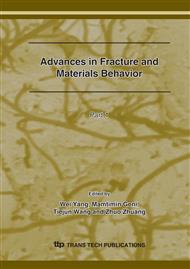p.597
p.603
p.609
p.617
p.623
p.631
p.639
p.645
p.651
Numerical Simulation of Different-Shaped Random Aggregates’ Influence on Concrete’s Compression Strength
Abstract:
A three-phase composite material specimen consisting of aggregates, mortar matrix and their bonding material is created through the Monte-Carlo method. The Mazars isotropic damage evolution model is used to describe the meso-mechanics damage deterioration of concrete. And the finite element method is adopted to simulate respectively the uniaxial compression numerical models of two, three and full graded specimens with sphere and polyhedron aggregates. Following are the conclusions from the test results: the ultimate load capacity of arbitrary polyhedron aggregate specimen is greater than that of the sphere one of the same grade; the size effect law exists in these numerical models of concrete specimens; the stiffness of the polyhedron aggregates’ specimen of the same grade is greater than that of the sphere ones’, and the softening curves of the sphere aggregate model are easier than those of the polyhedron by comparison in the softening phase of stress-strain curves.
Info:
Periodical:
Pages:
623-630
Citation:
Online since:
March 2008
Authors:
Price:
Сopyright:
© 2008 Trans Tech Publications Ltd. All Rights Reserved
Share:
Citation:


